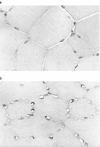Angiogenesis gene therapy to rescue ischaemic tissues: achievements and future directions
- PMID: 11487503
- PMCID: PMC1572862
- DOI: 10.1038/sj.bjp.0704155
Angiogenesis gene therapy to rescue ischaemic tissues: achievements and future directions
Abstract
Ischaemic diseases are characterized by an impaired supply of blood resulting from narrowed or blocked arteries that starve tissues of needed nutrients and oxygen. Coronary-atherosclerosis induced myocardial infarction is one of the leading causes of mortality in developed countries. Ischaemic disease also affects the lower extremities. Considerable advances in both surgical bypassing and percutaneous revascularization techniques have been reached. However, many patients cannot benefit from these therapies because of the extension of arterial occlusion and/or microcirculation impairment. Consequently, the need for alternative therapeutic strategies is compelling. An innovative approach consists of stimulating collateral vessel growth, a natural host defence response that intervenes upon occurrence of critical reduction in tissue perfusion (Isner & Asahara, 1999). This review will debate the relevance of therapeutic angiogenesis for promotion of tissue repair. The following issues will receive attention: (a) vascular growth patterns, (b) delivery systems for angiogenesis gene transfer, (c) achievements of therapeutic angiogenesis in myocardial and peripheral ischaemia, and (d) future directions to improve effectiveness and safety of vascular gene therapy.
Figures


References
-
- ASAHARA T., MASUDA H., TAKAHASHI T., KALKA C., PASTORE C., SILVER M., KEARNE M., MAGNER M., ISNER J.M. Bone marrow origin of endothelial progenitor cells responsible for post-natal vasculogenesis in physiological and pathological neovascularization. Circ. Res. 1999;85:221–228. - PubMed
-
- ASAHARA T., MUROHARA T., SULLIVAN A., SILVER M., VANDERZEE R., LI T., WITZENBICHLER B., SCATTEMAN G., ISNER J.M. Isolation of putative progenitor endothelial cells for angiogenesis. Science. 1997;275:965–967. - PubMed
-
- BAFFOUR R., BERMAN J., GARB J.L., RHEE S.W., KAUFMAN J., FRIEDMAN P. Enhanced angiogenesis and growth of collaterals by in vivo administration of recombinant basic fibroblast growth factor in a rabbit model of acute lower limb ischemia: dose-response effect of basic fibroblast growth factor. J. Vasc. Surg. 1992;16:181–191. - PubMed
-
- BANAI S., JAKLITSCH M., CASSCELLS W., SHRIVASTAV S., CORREA R., EPSTEIN S.E., UNGER E.F. Effects of aFGF on normal and ischemic myocardium. Circ. Res. 1991;69:76–85. - PubMed
Publication types
MeSH terms
LinkOut - more resources
Full Text Sources
Other Literature Sources
Medical

